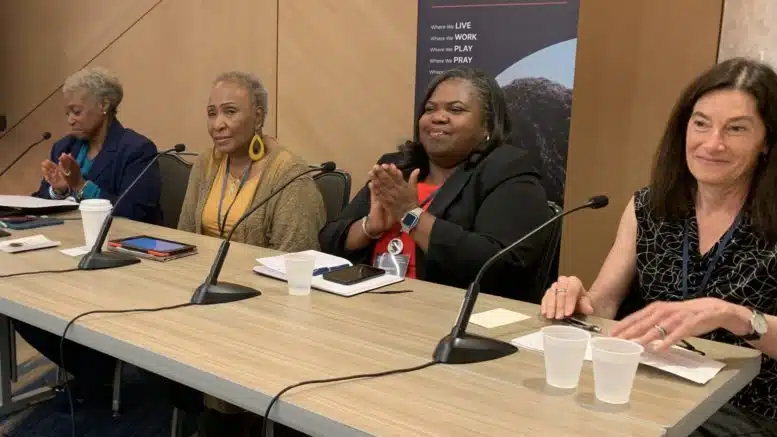By Will Atwater
The Autumn of 1982 was turbulent for Warren County, N.C., residents. Then-Gov. Jim Hunt decided to place a toxic waste landfill in the Afton community to house soil laced with polychlorinated biphenyls, or PCBs, that had been collected from sites where it was illegally dumped along a several-hundred-mile stretch of state roads.
For six weeks, hundreds of primarily Black residents and their allies received national and international intention for staging protests. They used their bodies as human shields to prevent trucks loaded with contaminated soil from reaching the landfill.
Although protesters could not stop the dump from being placed in their community, their actions helped give rise to what is now known as the environmental justice movement. Four decades later, what started as a fringe grassroots movement is finding footing in mainstream spaces.
And now, from a small gallery in Durham to the Museum of Modern Art in New York City, photo exhibits are displaying the ongoing influence of Warren County’s story.
In Durham: “We Birthed the Movement: The Warren County Landfill Protests, 1978-1982.” Now on display through the end of the year in the Kenan-Keohane Gallery on the first floor of the West Duke Building on Duke University’s East Campus.
The nearest exhibit is on Duke’s campus, where leaders have committed to becoming climate neutral by 2024.
“It’s important for the Duke community to understand the story of Warren County and other grassroots movements so that we can incorporate environmental justice into all of our sustainability efforts,” said Kay Jowers, director of Just Environments at Duke University’s Kenan Institute for Ethics and the Nicholas Institute for Energy, Environment & Sustainability.
The exhibit emerged from a collaboration between Warren County residents and the UNC Chapel Hill Wilson Library staff in conjunction with the 40th anniversary commemoration of Warren County PCB protests, which took place in 2023.
All of these retrospectives place the tiny rural North Carolina location squarely in the middle of a worldwide movement.
Out from the shadows
Last month, Dollie Burwell came home to Warren County inspired. She’d been in Washington, where she was lauded for her involvement in the 1982 protests and subsequent decades of activism.
Burwell had been invited to the Women’s Environmental Leadership Summit 2023, sponsored by The Center for Environmental Justice at the Smithsonian’s Anacostia Community Museum.
“My biggest excitement came from seeing the young people,” Burwell reflected. “How passionate they were about environmental justice!”
Burwell and her colleagues — Shauna Williams, Consherto Williams and Jenny Labalme — participated in a panel discussion on The Women of Warren County, where the four shared their recollections from the 1982 Warren County PCB Protests.
PCBs — manufactured chemicals used primarily in oils acting as insulators and coolants in transformers and other electrical equipment — were widely used in the United States from 1929 until 1979, when they were banned. PCBs are considered toxic and carcinogenic, and exposure to them can result in a suppressed immune system and may cause cancer, among other adverse health effects.
In Washington, D.C., The Anacostia Community Museum’s exhibit “To Live and Breathe: Environmental Justice in Washington, D.C.” celebrates women who played instrumental roles in fighting for solutions to environmental issues in places such as the nation’s capital and beyond. The exhibit runs through early January 2024.
A statement on the museum’s website captures the exhibit’s purpose.
“America has a long history of clustering heavy industry and toxic facilities in communities where people of color live. But in the 1980s, a series of events sparked a movement to fight back against these environmental injustices. We trace the history of the environmental justice movement from the farmlands of North Carolina to a watershed moment in the nation’s capital.”
“It’s really helpful to step back and consider what people before us did, what their successes were, where they struggled and how we can […] build off of that to further our own [environmental] goals,” Duke University freshman Aaron Ng said.
Ng is enrolled in a course taught by Jowers, who organized a field trip to the Anacostia Community Museum for her students to learn more about the environmental justice movement.
In New York City, The Museum of Modern Art is hosting an exhibit that pays tribute, in part, to the environmental justice movement. The show is titled “Emerging Ecologies: Architecture and the Rise of Environmentalism,” and includes a section about the Warren County protests. The exhibit runs through late January 2024.
Arriving at this moment
In 1982, Warren County burst onto the national and international stage as media coverage documented the six-week-long protests to block a hazardous waste landfill from being placed there. Although the demonstrations ultimately failed, activists had sown the seeds of something larger, something that ultimately had global reverberations.
“Why we were fighting to prevent that dump from being in Warren County, right in our community, was the impact it had on the way we lived, the way we loved and enjoyed our surroundings,” Consherto Williams said.

Credit: The Jerome Friar Photographic Collection and Related Materials, Wilson Library, UNC-Chapel Hill, used with permission.
As a teenager, Williams and one of her friends were photographed marching in one of the protest rallies.
In 1991, at the First National People of Color Environmental Leadership Summit, attendees developed an alternative definition of the word “environment.” They declared “environment” as “where one lives, works, studies, plays, and prays.”
Another significant contribution during the 1991 meeting was the development of 17 Principles of Environmental Justice. These declarations sent a message to the world that communities of color demanded a seat at the table. They demanded their voices be heard on environmental issues that often disproportionately affect their communities.
Black women are credited for taking a lead role in this effort.
“For 100 years, Black women have been saying that the environment shapes health, and where you live and where you work has a lot to do with how healthy your body is,” said Rachel Seidman, curator of Women’s Environmental History at the Anacostia Community Museum.
“The [environmental justice] movement has had a profound impact on the way that environmentalists, policymakers, activists and the general public” view the topic, Seidman said. “What you’re seeing in museums reflects this profound impact that the movement — not just Warren County, but the national movement — has had on all those things.”
“Environmental issues and environmental politics are now mainstream,” said Matthew Wagstaffe, assistant curator of the MoMA display. Wagstaffe points to climate change as a primary reason why Warren County’s legacy is receiving attention from venues such as MoMA, where, on a given day, thousands of visitors can experience the exhibit and learn about environmental justice.
“When you see things like sea-level rise disproportionately affect people in certain areas and not others,” Wagtaffe said, “this notion that environmental problems can be solved in a technical way, totally removed from the […] larger social justice issues, doesn’t make sense to anybody anymore.”
Building on legacy
As the history of the environmental justice movement continues to find space in prominent exhibition venues, a looming question for Warren County residents is, what’s next?
Established in 2012, the Warren County Environmental Action Team now has nonprofit status and can apply for grants and other funding to address lingering environmental questions.
The group is eyeing the Justice 40 Initiative, a Biden administration program to ensure that 40 percent of federal investments go toward supporting “disadvantaged communities that are marginalized, underserved and overburdened by pollution.”

Many residents are calling for a community health assessment, in hopes it will provide answers to decades-old questions about the possible relationship between illnesses in the community and the former toxic waste dump.
A health assessment would not only benefit Warren County, “but it could benefit other communities dealing with environmental justice issues,” said Margaret Brake, Warren County health director.
Another goal is to convert the former South Warren Elementary School building into a “center for excellence” that would support environmental justice work, among other things, said Bill Kearney, WCEAT’s board president.
Sign up for our Newsletter
“*” indicates required fields
Kearney said it’s time for Warren County to benefit from its contribution to the environmental justice movement.
“Now we want to be more structured, more successful as we go forward and bring solutions to our community, and take the position God has given us as the point of the spear when it comes to environmental justice and climate change.”
Reporting for this story was supported by the Wake Forest University 2023 Environmental and Epistemic Justice Summer Institute.










